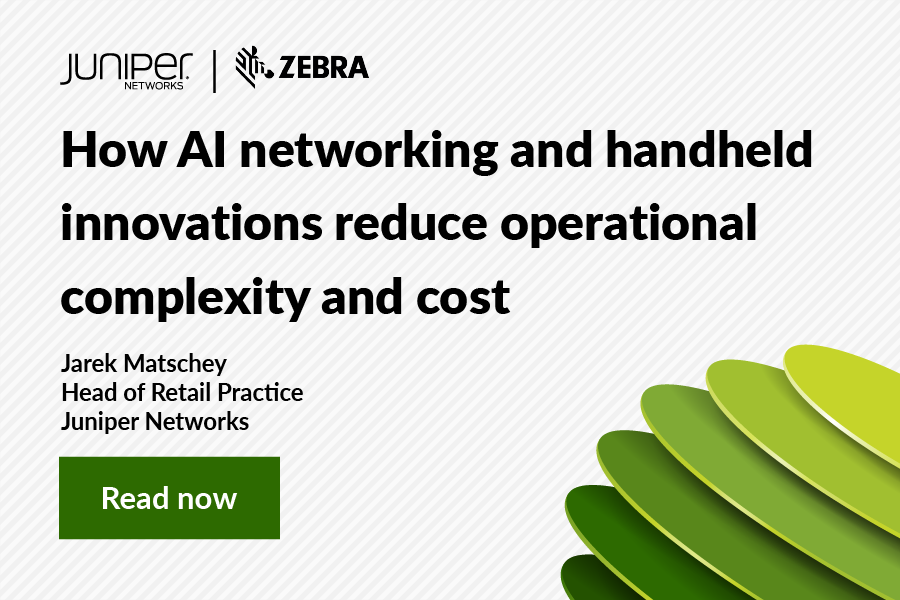Juniper’s Virtual Retail Summit recently took place on June 9. Here are six key takeaways from the event, which is now available to watch on demand.
From online purchases and home delivery to click-and-collect and appointment-driven shopping, new consumer buying habits have changed the retail landscape. So, what should retailers now be focused on to ensure that they can deliver highly individualized experiences in-store and online, as part of their strategy for growth?
KEY TAKEAWAY 1: Prioritize IT Investment
Retailers are focusing on digitally transforming operational models for a better customer experience and IDC predicts that[i]:
“By 2025, digital shelves, RT inventory visibility, robotic fulfillment, and automated checkout will accelerate investment in connected store edge platforms by two years and 10x over current forecast levels.”
—Giulio Raffaele, Research Manager, IDC Retail Insights
Innovative retailers are investing in new store types, proprietary technology, eCommerce and IoT Commerce. These areas will contribute most to revenue generation over the next three years and Juniper Networks can help them achieve their transformation goals and stay ahead in the marketplace.
Bringing AI to IT, retailers can leverage Juniper Mist™ for contactless retail, retail commerce platforms and real-time contextual store experiences. To ensure contactless models perform at speed and scale, a retail commerce platform built upon a hybrid multicloud architecture is required and real-time contextual customer journey models must be supported by AI-driven value chains. All three are designed to enhance the customer experience and with a software-defined enterprise, Juniper Mist’s AI solutions can deliver exceptional end-to-end user and IT experiences.
KEY TAKEAWAY 2: Customers Now Expect Stores to be Connected
Experience is key in the “new normal” as customers return to physical stores. Influenced by their new shopping habits, consumers will continue to welcome the omnichannel experience and expect applications that blend the virtual and physical worlds, such as ordering and paying for their drink on their smartphone before arriving in the coffee shop, where it will be ready for them when they arrive.
“Outletcity Metzingen’s vision is to offer every guest the best shopping experience at any touchpoint, which inspires us to work every day with the spirit of passion and innovation.”
—Simon Drees, Director, Omnichannel Services & Innovation, Outletcity Metzingen
While mobile checkouts, self-scanning and click-and-collect are not new applications, they are now being utilized more than ever before. Sainsbury’s online sales have increased by 87 percent, Tesco UK reported an increase of 48.5 percent, and Inditex saw an online sales growth of 74 percent. This means customer and colleague applications have become business-critical and now the connected customer experience has become an everyday expectation, the network simply being “up” is no longer good enough.
KEY TAKEAWAY 3: Leverage Data Analytics
Measuring application experience from the client-to-cloud is now critical. If an app fails or performs poorly, the shopping experience immediately becomes negative. What should have been a smooth and easy transaction becomes an inconvenience, especially if the customer is now unsure whether or not their payment was taken, which could leave them wondering how they can be issued a refund. After spending more time investigating and fixing the problem than if they had instead ordered in-store, the frustrated customer is then likely to share the experience with friends and quite possibly on social media, too. The negative experience is then at risk of becoming public.
“Our customers are very happy with the Wi-Fi. The Juniper network, driven by Mist AI, is so good that we rarely have problems with the Wi-Fi or device connections.”
— Sebastian Stelter, Team Lead Project Management and Service Support, Outletcity Metzingen
Retailers can avoid such issues when they are able to measure and report against SLAs for all applications. With full end-to-end visibility across all locations, Juniper Mist can play a crucial role in managing individual customer exceptions and troubleshooting network issues, often detecting and remediating problems before customers ever notice them.
KEY TAKEAWAY 4: Combine AI Operations and Automation
One of the biggest challenges can be network troubleshooting, with countless hours wasted trying to prove or disprove that the problem was the Wi-Fi. Only Juniper has a complete client-to-cloud portfolio with Marvis, the AI-driven Virtual Network Assistant, for rapid root cause identification and remediation across the wired LAN, wireless LAN, and WAN. Other benefits include:
- No controllers
- APIs that can handle all configuration needs
- Templating that saves time and offers consistency
- Scripts can be edited quickly
- Overnight engineers are no longer needed
- Access can be provided across the IT team
“Before Mist, we spent a lot more time troubleshooting. Now, we can slice and dice the data and see very clearly that we’re having a problem at a specific store.”
—Snehal Patel, Director of Global Infrastructure Architecture, Gap Inc.
The deployment of Marvis offers greater visibility across a fleet of stores, helping to troubleshoot issues faster and establishing whether it is a network problem or something else. Using the available data, such as SLEs, the coverage and roaming criteria, Marvis can tell remotely if a store has any issues and reduce the number of on-site visits needed.
KEY TAKEAWAY 5: Add Value with Location-Based Services
Connectivity has evolved, especially during the pandemic, when the retail sector has embraced technology to assist in complying with strict regulations. Limits on how many shoppers are allowed per square meter in stores have led to heavy queueing and crowds, so to make shopping more convenient and safer, mobile check-ins have been deployed to enable customers to queue virtually.
“To achieve greater digitalization of the shopping experience, we needed an excellent network infrastructure. A Juniper network enables us to deliver that experience.”
—Snehal Patel, Director of Global Infrastructure Architecture, Gap Inc.
Having a digital infrastructure has been business-critical and enables new services, like personalized greetings and notifications, location-based alerts and directions, and asset visibility and traffic analytics. Real-time tracking of in-store customers helps to answer questions such as “Are there any blockages or spillages in the aisles?”, while long-term and short-term time traffic trends and new approaches to sustainability can be achieved, from green energy in stores to charging points for electric cars.
KEY TAKEAWAY 6: Focus on Experience-First Networking
A great experience is essential and must be provided at every touchpoint. Juniper makes a seamless customer journey possible by providing a positive Wi-Fi experience and a technical infrastructure that can meet new demands. This is achieved through:
- APIs enabling integration with existing management platforms
- Enabling the delivery of a “store as a service”
- A flexible infrastructure that scales with demand and organizational growth
- Weekly upgrades that deliver new features with no downtime
- An AI-driven cloud as a service, leading to a more efficient, strategic and insight-driven network
While retailers may not know what is coming or what the next “normal” will be, they can now be agile and ready to deliver whatever will be needed through the AI-driven network.
Watch the entire Virtual Retail Summit on demand (90 minutes)
[i] *IDC InfoBite, sponsored by Juniper Networks, Leveraging Autonomous Networks to Enhance Control and Predictability in the Retail Next Normal, doc #EUR147463721, March 2021


